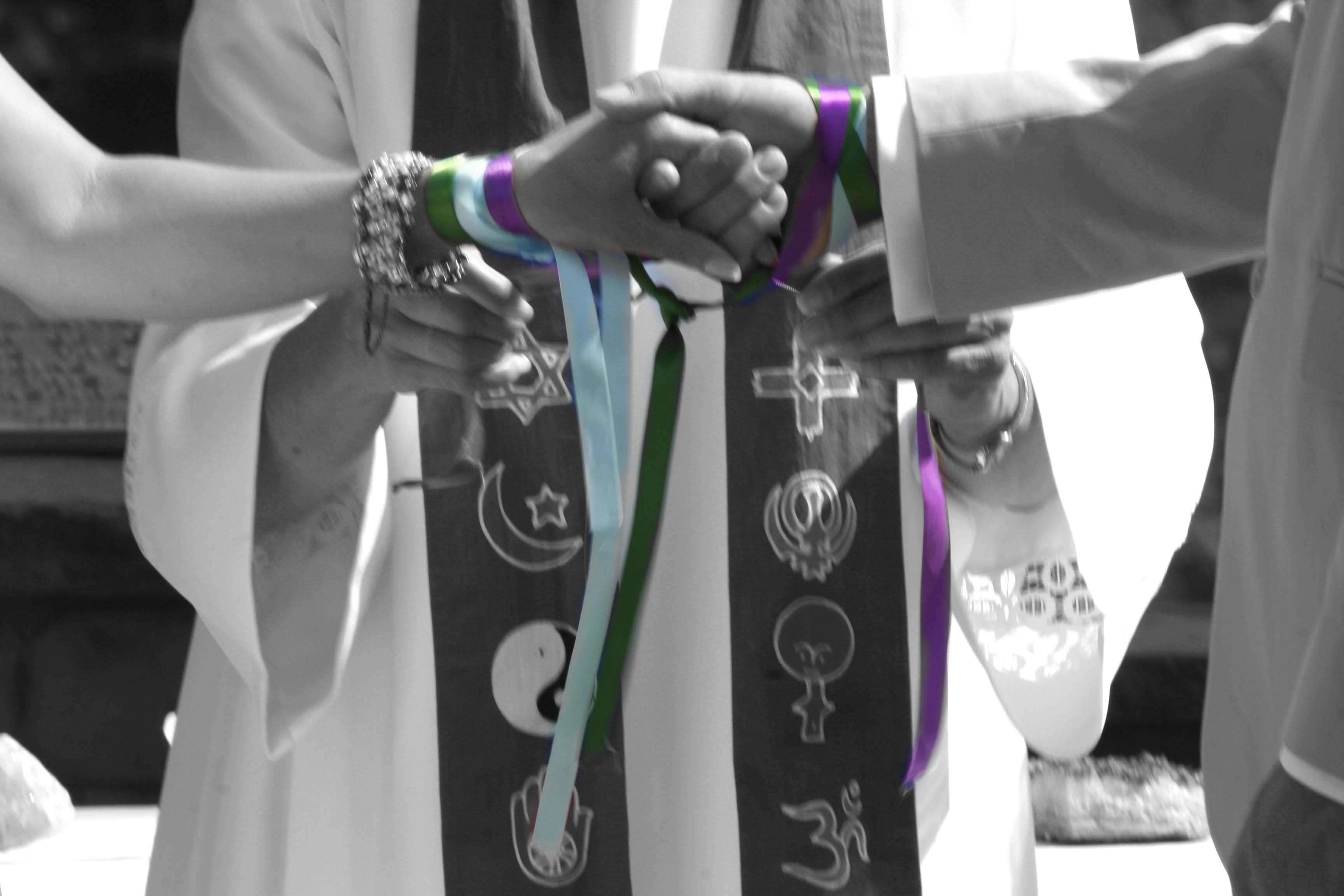Couples provide the ribbons or cords. They should be at least 4 ft long for a ceremony where 2 hands are tied. To tie 4 hands, the cord should be 8 ft long. The color interpretations can be your personal ones, but here are a few suggestions: Red represents a passion for life, physical energy and health. Orange shows sweetness, trust, and creativity. With yellow you bring in respect, personal power and spontaneity. Compassion, unconditional love, and balance are represented by green. Blue is the color of communication, contentedness, harmony and self expression. With Indigo you bring in intuition, wisdom, emotional intelligence and charisma. Violet represents peace, spirituality and selflessness. White is the color of purity and a connection with a Higher Power, God, Divine and Spirit.
We will borrow from the ancient custom of Handfasting for our Unity ceremony today. Handfasting is a traditional form of betrothal, the origins of which are largely lost in the mists of time. It is from this ritual that the term “tying the knot” originated.
__________and _________ please join your right hands and then your left. Note that you have just made the infinity symbol representing that love has no beginning and no end. (Officiant then takes the cord and wraps around one person’s left hand and the other person’s right. As she does so she explains the significance of the color(s) selected by the couple. )
Heart to heart, and hand to hand, you are joined together in marriage. The ___ ribbon brings blessings of ______________. The ____________ribbon symbolizes__________With _______we bring in_________etc.
______and _________ you are now not only joined in love, but also in commitment. May your days together be filled with joy, adventure and peace.
Version 2: Each ribbon represents a blessing. Tying can be done by officiant or others. Officiant does all the reading.
We will borrow from the ancient custom of Handfasting for our Unity ceremony today. Handfasting is a traditional form of betrothal, the origins of which are largely lost in the mists of time. It is from this ritual that the term “tying the knot” originated. ______ and __________ please join hands.
(As the blessings are read, different color ribbons are tied on their joined hands. The tying can be done by the officiant, bridal party, or family members. . The number of ribbons and blessing must equal the number of people tying. If the officiant, ties you may have as many/few ribbons/blessings as you like. You can add whatever blessings you choose and have as many (or as few) as you like. Some suggestions are love, tenderness, compassion, communication, laughter, acceptance, abundance, strength, understanding, patience etc.)
May this marriage be blessed with _____________
May this marriage be blessed with _____________
May this marriage be blessed with _____________
May this marriage be blessed with _____________
May this marriage be blessed with _____________
May your lives be blessed .always.
Version 3: Bridal party members select ribbon colors and blessings
for the couple. Bridal party members tie and each speaks the
significance of the color and their blessing/wish as they tie the
couple’s joined hands.
We will borrow from the ancient custom of Handfasting for our Unity
Ceremony today. Handfasting is a traditional form of betrothal, the
origins of which are largely lost in the mists of time. It is from
this ritual that the term “tying the knot” originated. _______and
________ please join hands. The bridal party will be tying
the ribbons as they send the couple wishes and blessings.
The bridal party walks forward one at a time (alternating sides) As
they tie, they speak the significance of the color and the
wish/blessing,
Version 4:Bridal party members select ribbon colors and blessings
for the bride and the groom as individuals. Bridal party members
tie a ribbon on either the groom’s or the bride’s hand and each
speaks the significance of the color and their blessing/wish as
they tie. Officiant then takes the hanging ribbons and makes one
final knot representing the union.
We will borrow from the ancient custom of Handfasting for our Unity
Ceremony today. Handfasting is a traditional form of betrothal, the
origins of which are largely lost in the mists of time. It is from
this ritual that the term “tying the knot” originated. ____ and
_________ please join hands. The bridal party (or others of
your choice) will be tying the ribbons as they send the
couple wishes and blessings.
The bridal party walks forward one at a time (alternating bride’s
side, grooms side) As they tie, they speak the significance of the
color and the wish/blessing. They can pick their own colors and
blessings. For example: Yellow is for laughter. Green is for
abundance. Blue is for communication. Purple is for spirituality.
Red is for love.
Officiant then takes all the ribbons and ties them together below
the couples joined hands saying. May this marriage be blessed with
these many gifts.
Version 5: Bridal party selects ribbons and blessings. Officiant
reads as they tie couple's joined hands.
We will borrow from the ancient custom of Handfasting for our Unity
Ceremony today. Handfasting is a traditional form of betrothal, the
origins of which are largely lost in the mists of time. It is from
this ritual that the term “tying the knot” originated. _____and
________ please join hands.
The bridal party has selected the ribbon colors for this ceremony,
each representative of a wish or a blessing.
Officiant reads the colors, state who they are from and the
blessing as the bridal party members come forward to tie.
________has chosen a ________-ribbon, representing her blessing
of _______ (they come forward and tie the couple’s joined
hands )
________has chosen a ____ribbon, representing his blessing
of ______ (they come forward and tie the couple’s joined
hands)
Additional options can be found in the Reserved for Booked Couples section.
.


